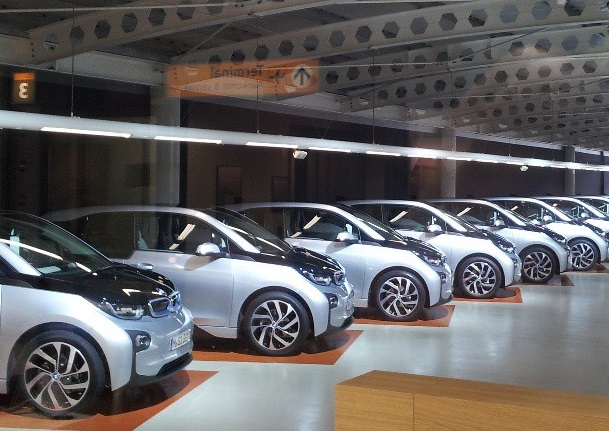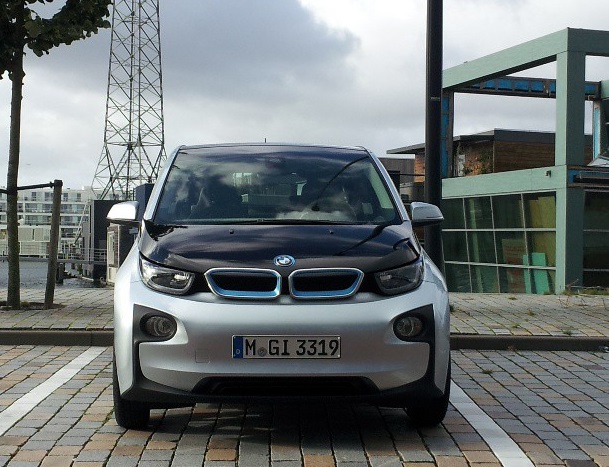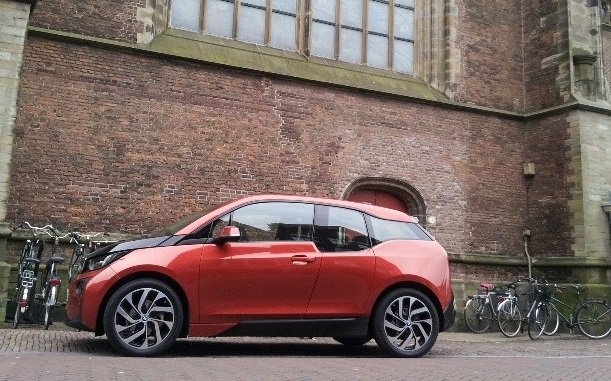You may have read stories lately that suggest the BMW i3 is the first luxury competition for the Tesla Model S electric car.
It’s not.
You may also have read that it’s the first range-extended car to go head to head with the Chevrolet Volt.
It’s not.
In building its first battery-electric vehicle, BMW has done precisely what it has been saying for three years it would do: build what may be the world’s best electric city car.

2014 BMW i3 (German-market version), Amsterdam, Oct 2013
The question is simply whether that’s relevant to a country where no head of household in recorded history has ever said, “Honey, let’s go buy a city car.”
Calming chaotic city driving
In two days of test-driving in and around Amsterdam, the i3 provided a driving experience that was both unexpected and quietly wonderful: It made chaotic stop-and-go traffic tolerable.
The design, sound insulation, and materials of the cabin simply calm occupants, an effect we’ve never experienced in a car before. And the quiet, effortless power and small dimensions make it easy to use even in crowded precincts.
MORE: 2014 BMW i3 Review
The roads of Amsterdam are occupied by pedestrians, bicycles, mopeds, motorcycles, private cars, commercial trucks, buses, and trams—often just inches from each other.
In that environment, the i3 showed its ability to accelerate rapidly, decelerate strongly enough to offer one-pedal driving in all but emergencies, and soothe the anxieties and irritations of driving in the chaotic traffic conditions of a crowded modern city.
But a soothing Scandinavian modern interior, in a car that’s probably at its best from 0 to 45 mph, will likely come as a very big shock to BMW’s loyal followers in the U.S.
For 30 years, they have thrilled to the idea of owning an “Ultimate Driving Machine”—and BMW has mostly delivered on that promise.
So the 2014 BMW i3 poses a ferocious challenge for BMW’s marketers in the States. We’re going to be very curious to see how the company positions, markets, and sells it smallest and most technologically advanced vehicle.
Constant stares
Our test drives, totaling more than 100 miles over two days, were in two German-market BMW i3 cars, one striking bronze, one a more predictable silver.
They drew stares wherever we drove, likely for the unusual upright shape and a design language for all BMW “I” vehicles that mandates a glossy black hood, roof, and tailgate—regardless of the color of the body sides.
The i3 is wide for its length, and two front-seat occupants have noticeable space between them. The wheels are pushed out to the corners, meaning the longest possible wheelbase for the length.
And indeed, BMW’s electric car “drives small”—you can place it fairly easily and, once you learn how wide it is, park it with ease.
Superb one-pedal driving
It’s the driving experience—specifically the aggressive regenerative braking—that sets the BMW i3 apart from any other electric car. We haven’t driven a car that makes one-pedal driving this easy since the original Tesla Roadster.
The company clearly spent a great deal of time refining the motor control software and pedal feedback over earlier versions used in the BMW ActiveE test fleet. (We’ll pass swiftly over the distressing driving characteristics of the earlier MINI E test fleet.)

2014 BMW i3 (German-market version), Amsterdam, Oct 2013
The i3 has by far the best, and best modulated, regenerative braking we’ve driven. The 125-kilowatt (170-horsepower) motor delivers up to 50 kW of regeneration to recharge the 22-kilowatt-hour lithium-ion battery pack in the floorpan. (BMW says 18.8 kWh of the pack capacity is available to propel the car.)
That turned out to be enough to slow the car to a standstill, even on a steep downhill parking ramp—to the surprise of the driver.
Unlike the old Roadster, the BMW i3 regeneration can slow the car right down to a stop. Once a driver gets used to the characteristics of the accelerator pedal—and learns to look for the gliding mode on the power-delivery meter—it’s rarely necessary to touch the brake pedal at all.
This stands in sharp contrast to electric cars like the Chevrolet Volt, the Nissan Leaf, and even the Tesla Model S. Those cars all, to various degrees, mimic the behavior of a conventional car with an automatic transmission.
The i3 has no idle creep, and after a day of driving with one pedal, you’ll wonder why any other plug-in car would bother with it.
Providing such aggressive regen means the braking system is entirely conventional; it need not blend regenerative and friction stopping, as other cars—including hybrids—do. It’s really just for sudden maneuvers and panic stops.
We did, however, notice a distinct creaking as the car came to a stop using the brake pedal. BMW chassis engineers said it was a known issue having to do with a slight slippage of the brake pads on the discs at the point just before the car stopped entirely, and that they were working on a fix.
Range around 80 miles?
The EPA has not yet released its range and efficiency ratings for the U.S. version of the 2014 BMW i3. Our two test cars started with indicated ranges of 82 and 88 miles, and their end-of-day ranges and distance covered largely confirmed the accuracy of the estimates.
BMW says it’s completed the EPA test cycles and that official range and efficiency ratings will be released “soon.” If we had to lay money, we’d bet on 75 to 85 miles—BMW blithely quotes “80 to 100 miles” based on less aggressive European test cycles.
We should note that our two days of driving were on almost entirely flat terrain (that’s Holland), and that while we had a few segments of highway speeds, most of the driving was from 20 to 50 mph. Driving the car largely at highway speeds will obviously reduce range.
On the European test cycle, BMW says the i3 covered more than 4 miles for every kilowatt-hour of usable energy in the battery. That would put range around 80 miles, perhaps more.
And range of around that level—comparable to the 2013 Nissan Leaf’s 75 miles, or the 62 to 105 miles for a variety of much lower-volume battery electric cars—means that the 2014 BMW i3 simply isn’t a Tesla Model S competitor.
Not to mention its bread-van shape, its heavy focus on multi-modal urban transport, and its relative lack of cargo capacity.
Range extender: the big unknown
All of the BMW i3 test cars in Amsterdam were the battery-electric version. This is the version the company expects to predominate in European sales.
BMW executives acknowledged that North American buyers will likely want the added security of the 25-kW (34-hp) range extending two-cylinder engine and generator—which adds $3,850 to the price—although they stress that it will increase weight, reduce electric range, and probably not be used as much as owners imagine.

2014 BMW i3 (German-market version), Amsterdam, Oct 2013
The company even suggested that it may try to discourage buyers from choosing the range-extended model, perhaps by letting them take home a battery-electric version for a week.
If buyers truly found that the car didn’t have enough range for their week’s worth of travels (assuming overnight plugging in), BMW would then let them upgrade to the range-extended version. We’ll see how (or whether) that idea plays out in real-world sales.
But because the company has said that the range extender is not for daily use, but for emergencies and unusual situations, it remains unclear whether the i3’s performance in range-extending mode will be compromised.
Asked directly about the case of a 12-mile uphill grade of 5 percent at highway speeds with four people in the car, the powertrain executive for the car said that passengers wouldn’t notice any difference in performance.
Until we drive a BMW i3 in range-extending mode, we can’t assess whether the car’s a viable Chevy Volt competitor. Both cars have four seating positions, with somewhat tight rear seats. The BMW comes in almost $10,000 more expensive, but then it has a German luxury brand rather than an all-American bowtie on the grille.
Styling mish-mosh
The 2014 i3’s most successful aspects are the front and front three-quarter views. The only clues to its carbon-fiber reinforced plastic (CFRP) body shell and separate aluminum chassis carrying all the running gear come when you open the door and see a few exposed, unpainted plastic surfaces.
From the front, the electric car leads with a slightly more geometrical version of the classic BMW twin-kidney grille. It’s more of a polygon than the rounded-corner grilles on gasoline and diesel models.
The two blanking plates that sit where air would normally pass into the “engine compartment” are outlined in a medium blue tone—signaling the car’s unusual battery-electric powertrain.
The base of the windshield is quite far forward, giving the front an appealing snub-nosed appearance. But move around to the side, and strange things start to happen.
There’s a very practical dip in the window line for the second door, but then the belt line rises again to a level above that of the front doors—giving the car three different horizontal lines on the side, plus a window line that dips down from the roof to make the rear window shallower than it could be.
BMW calls this “stream flow” design—we’ll see it on other BMW “I” cars, including the upcoming i8 plug-in hybrid sport coupe—but it goes far beyond the window lines of the Hyundai Genesis Coupe and the Honda Odyssey minivan, the only other cars to have a rear window lower than the front.
Then, at the rear, it all falls apart. The tailgate is a shiny black glass hatch that contains the rear lights in it, but sits slightly ahead of the body sides that flank it, which protrude in a way that looks like vestigial fins. Then there’s the rear bumper shield, which rises high up to the base of the load floor—which is higher than you’d expect because it has the electric drive motor underneath it.
Scandinavian modern loft
Inside, to our eyes, the BMW i3 is both distinctive and modern.
The designers worked hard to convey a sense of space, and they succeeded, even if some of that interior volume sits beyond the dashboard or in places that it’s not all that useful to passengers.
The design chief for the i3 said that starting with a clean sheet of paper and building a car like no BMW that came before let them consider what would be the most appropriate interior for a city car. And he cited the open feeling and minimalist furnishings of a loft apartment as an inspiration.

2014 BMW i3 (German-market version), Amsterdam, Oct 2013
The result is a cabin that feels spacious, gracious, and simple.
That was a challenge for the company: “We are not good at subtracting things from the cars that we make,” admitted one designer in conversation.
Free-floating displays
Both displays on the dashboard—a 10-inch central screen and a smaller one visible to driver through the steering wheel—float above the dashboard surface on stalks.
That keeps the dash top low; it also extends a long way forward to the base of the windshield, amplifying the openness.
The woven seat fabric somehow conveys luxury even in its simplicity, and open-pore eucalyptus wood on the flip-up glovebox door erases any hint of glossy wood finishes.
Contrasting stitching on leather surfaces, which are tanned using non-toxic olive dyes, and a variety of textures and materials come together in a way that really does make the cabin a calming and soothing place.
Unfinished surface?
To our eyes, the one dissonant note is the kenaf renewable-fiber material used for both the farther reaches of the dash top and the forward portions of the door interiors.
Frankly, it looks as though it’s the backing material that sits behind a covering—that the factory somehow inexplicably omitted.
Even after a day of watching out for cyclists, traversing hundreds of traffic-calming speed bumps, and shooting down narrow one-way canal-side one-lane streets, the BMW i3 was easy, predictable, and relaxing to drive.
It’s hard to imagine the extra effort that would have been required to cover the same route in, say, the typical European diesel subcompact hatchback—especially one now fitted with a start-stop system.
Push to go
Like any battery car, the BMW i3 utterly dispenses with engines turning on and off, transmissions shifting, and all the other drama we’ve accepted in cars with combustion engines.
It’s simplicity itself: With the proximity fob in your pocket or in a cupholder, push the start button that’s on the rotary drive knob behind the steering wheel, release the parking brake, rotate the knob to “D”—and drive.
Push the accelerator to go, let up slightly to slow down or stop.
That’s really all there is to it.
Achilles’ Heel: handling
If the 2014 BMW i3 has an Achilles’ Heel, it’s the handling and roadholding at higher speeds. It’s fine around town, and adequate in large-scale suburban sprawl, but tight turns and switchbacks are not its happiest ground.
The tall, narrow tires (to reduce aerodynamic drag at high speeds) have a contact patch that’s much longer than it is wide—the reverse of most modern tires. In corners, it’s surprisingly easy to make them squeal in even halfway aggressive driving.
The car does actually hang on, but the high seating position exacerbates the feeling of body roll. BMW quotes a cornering force of about 0.80 G, but we experienced regular rear-wheel hop and back-end jitters while accelerating out of tight corners or tightening our line on turns.
If you drive smoothly, you may not notice the handling, but this car is simply not a road warrior. And it will never go up against BMW’s M line of performance cars—or even against a well-driven Mazda 3.
But that was never meant to be its mission in life. BMW has built a very good city car, one that does something that no other electric small car does: actually makes the driver willing to tolerate congestion and chaotic urban traffic.
How applicable that is to the majority of Americans who live in suburban sprawl remains to be seen.
If you want an electric car with a range of less than 100 miles, this is a very good one.
If you want a Tesla Model S competitor, however … keep waiting. This isn’t it.
BMW provided airfare, lodging, and meals to enable High Gear Media to bring you this first-person drive report.
_______________________________________________













